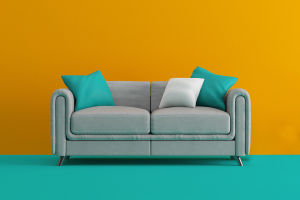In a world increasingly cluttered with information and material possessions, the appeal of simplicity in interior design has grown significantly.
The modern interpretation of simplicity, often encapsulated in the concept of minimalism, goes beyond mere aesthetics. It represents a lifestyle choice that prioritizes functionality, serenity, and a sense of space.
Principles of Simple Interior Design
At its core, simple interior design is about stripping away the unnecessary to focus on what truly matters. This approach emphasizes clean lines, uncluttered spaces, and a restrained color palette. The guiding principles include:
1. Functionality Over Form: Every element in a minimalist design serves a purpose. Furniture and decor are chosen for their utility as much as for their aesthetic appeal. This ensures that each piece contributes to the overall harmony and functionality of the space.
2. Quality Over Quantity: In a minimalist space, fewer items are present, but those that are included are often of higher quality. This focus on craftsmanship and durability means that each piece is not only beautiful but also built to last.
3. Neutral Color Palette: Colors in minimalist design are typically neutral, such as whites, grays, and beiges. These colors create a calming backdrop that enhances the sense of space and allows other elements, like furniture and artwork, to stand out.
4. Natural Light and Open Spaces: Minimalist interiors often feature large windows and open floor plans. Natural light enhances the feeling of openness and reduces the need for artificial lighting, creating a more sustainable and pleasant living environment.
Practical Applications in Contemporary Spaces
Implementing simplicity in interior design requires thoughtful planning and a keen eye for detail. Here are some practical ways to bring minimalist principles into contemporary living spaces:
1. Declutter Regularly: The first step towards a minimalist home is decluttering. Regularly assess your belongings and remove items that no longer serve a purpose or bring joy. This practice helps maintain an uncluttered environment and frees up space for more meaningful items.
2. Choose Multi-Functional Furniture: Opt for furniture that serves multiple purposes, such as a sofa bed or a coffee table with storage. These pieces maximize functionality while minimizing the number of items in a room.
3. Embrace Open Shelving: Open shelving units are both practical and aesthetically pleasing. They allow you to display essential items and decorative pieces without creating visual clutter. Keep the displays simple and curated for maximum impact.
4. Incorporate Natural Elements: Bring the outdoors in by incorporating natural materials like wood, stone, and plants. These elements add warmth and texture to a minimalist space, creating a more inviting and organic atmosphere.
5. Limit Color Accents: While a neutral palette is the foundation of minimalist design, carefully chosen color accents can add interest and personality. Use colors sparingly and in small doses, such as through artwork, throw pillows, or a single statement piece of furniture.
The beauty of simplicity in modern interior design lies in its ability to create spaces that are both functional and serene. By embracing minimalist principles, homeowners can transform their environments into havens of tranquility and efficiency.
The focus on quality, functionality, and timeless appeal ensures that minimalist interiors remain not only aesthetically pleasing but also practical and sustainable. As the world continues to evolve, the allure of simplicity in interior design stands as a testament to the enduring value of less truly being more.


